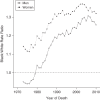Decomposing Black-White Disparities in Heart Disease Mortality in the United States, 1973-2010: An Age-Period-Cohort Analysis
- PMID: 26199382
- PMCID: PMC4528952
- DOI: 10.1093/aje/kwv050
Decomposing Black-White Disparities in Heart Disease Mortality in the United States, 1973-2010: An Age-Period-Cohort Analysis
Abstract
Against the backdrop of late 20th century declines in heart disease mortality in the United States, race-specific rates diverged because of slower declines among blacks compared with whites. To characterize the temporal dynamics of emerging black-white racial disparities in heart disease mortality, we decomposed race-sex-specific trends in an age-period-cohort (APC) analysis of US mortality data for all diseases of the heart among adults aged ≥35 years from 1973 to 2010. The black-white gap was largest among adults aged 35-59 years (rate ratios ranged from 1.2 to 2.7 for men and from 2.3 to 4.0 for women) and widened with successive birth cohorts, particularly for men. APC model estimates suggested strong independent trends across generations ("cohort effects") but only modest period changes. Among men, cohort-specific black-white racial differences emerged in the 1920-1960 birth cohorts. The apparent strength of the cohort trends raises questions about life-course inequalities in the social and health environments experienced by blacks and whites which could have affected their biomedical and behavioral risk factors for heart disease. The APC results suggest that the genesis of racial disparities is neither static nor restricted to a single time scale such as age or period, and they support the importance of equity in life-course exposures for reducing racial disparities in heart disease.
Keywords: United States; age-period-cohort models; blacks; health status disparities; heart diseases; whites.
Published by Oxford University Press on behalf of the Johns Hopkins Bloomberg School of Public Health 2015. This work is written by (a) US Government employee(s) and is in the public domain in the US.
Figures






Comment in
-
Invited Commentary: A-P-C... It's Easy as 1-2-3!Am J Epidemiol. 2015 Aug 15;182(4):313-7. doi: 10.1093/aje/kwv052. Epub 2015 Jul 20. Am J Epidemiol. 2015. PMID: 26199381
-
Kramer and Casper Respond to "A-P-C... It's Easy as 1-2-3!".Am J Epidemiol. 2015 Aug 15;182(4):318-9. doi: 10.1093/aje/kwv049. Epub 2015 Jul 20. Am J Epidemiol. 2015. PMID: 26199383 Free PMC article. No abstract available.
References
-
- Centers for Disease Control and Prevention. Decline in deaths from heart disease and stroke—United States, 1900–1999. MMWR Morb Mortal Wkly Rep. 1999;4830:649–656. - PubMed
-
- Cooper R, Cutler J, Desvigne-Nickens P, et al. Trends and disparities in coronary heart disease, stroke, and other cardiovascular diseases in the United States: findings of the National Conference on Cardiovascular Disease Prevention. Circulation. 2000;10225:3137–3147. - PubMed
-
- Kochanek KD, Arias E, Anderson RN. How did cause of death contribute to racial differences in life expectancy in the United States in 2010? NCHS Data Brief. 2013;125:1–8. - PubMed
-
- Ford ES, Ajani UA, Croft JB, et al. Explaining the decrease in U.S. deaths from coronary disease, 1980–2000. N Engl J Med. 2007;35623:2388–2398. - PubMed
Publication types
MeSH terms
Grants and funding
LinkOut - more resources
Full Text Sources
Other Literature Sources
Medical
Miscellaneous

